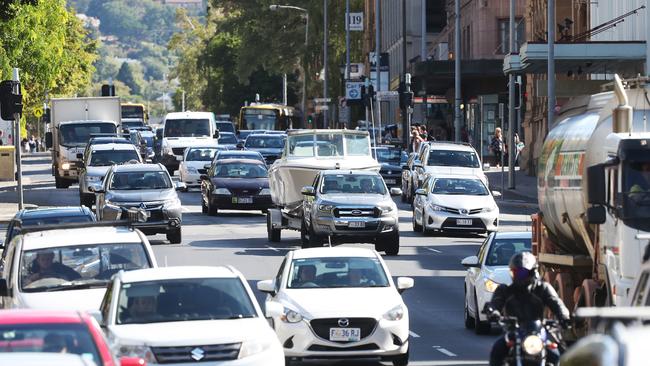Talking Point: Don’t dig us into a costly black hole
JOHN LIVERMORE: A tunnel is no solution to Hobart’s traffic congestion

Opinion
Don't miss out on the headlines from Opinion. Followed categories will be added to My News.
MADELEINE Ogilvie’s Talking Point “Only tunnels will solve Hobart’s traffic-jam woes” does not match the data she says should be injected into the debate.
After the Evers Network proposal for two interconnecting tunnels below Hobart to lessen traffic congestion, the Mercury quoted the proponents who said “the need for this type of visionary approach appears indisputable” (Editorial, October 2).
However, a Department of Infrastructure, Energy and Resources report in 2011, “Congestion in Greater Hobart: Response to Issues”, made critical comment on a similar proposal. Tunnels and bypasses, it said, were “vastly out of proportion to the traffic issues and reflects an infrastructure focus rather than a network or system wide perspective to address traffic issues.” The relative cost of building the tunnel (then proposed stage one from the Southern Outlet to the Brooker Highway) would cost around $1 billion ($900 million in the Evers Network proposal).
A 2008 traffic survey on Macquarie and Davey streets indicated a large proportion of traffic there was not through traffic but was Hobart CBD bound. The proposed tunnel was only likely to remove 15 per cent of the Macquarie-Davey traffic during the morning peak and 14 per cent in the evening. DIER concluded that building a tunnel or a bypass was unlikely to solve traffic issues on Macquarie-Davey because most traffic was not through traffic.
With the Brooker and Tasman Highway experiencing more traffic than Macquarie-Davey the proposed tunnel or a bypass around the CBD did not target roads that have higher volumes or experience greater delays. It was also noted that a tunnel would cause localised traffic congestion at either end because traffic would be forced onto higher volume roads such as Brooker and Tasman highways. The report raised concern that a tunnel or bypass would be likely to have an impact on Hobart’s many heritage buildings as a result of vibration and disturbance caused by drilling for tunnel construction.
A bypass would involve extensive property acquisition and impact on heritage homes between Molle and Melville streets.
An elevated freeway would also create a significant visual impact against the backdrop of Hobart CBD and the foothills of Mt Wellington, the lower slopes of which would also be affected by a bypass from McRobies Gully to South Hobart.
DIER also pointed out that tunnels require high traffic volumes to recoup costs and both the Brooker and Macquarie-Davey would be unlikely to have the traffic volumes to return the level of its investment.
Madeleine Ogilvie extols the virtues of the Brisbane tunnel but notes such tunnels do not come cheap or quick. In Brisbane, indications were that people were not prepared to pay $4.20 for the Clem7 tunnel. Initially the toll was free and as soon as the toll began, daily traffic volume dropped from 59,000 to 21,000.
A 2012 GHD report commissioned by DIER for Hobart City Council included analysis for a tunnel with a link from the Southern Outlet to the Brooker Highway. It said that in 2031 at peak morning traffic there would only be 1000 vehicles a day in the tunnel and 1000 in the afternoon peak. GHD confirmed 14 per cent of traffic on main feeder routes (Macquarie-Davey) was through traffic.
It follows that a western bypass argued by Bob Cotgrove (Talking Point, October 3) is not justified. Similarly the Evers Network tunnel proposal would not solve the current traffic congestion. It would cost $1 billion over 10 years, hardly a timely solution.
One point Madeleine Ogilvie makes I do agree with. The proposed southbound bus lane on the Southern Outlet does not make logistic sense. In 2005 the RACT proposed a park and ride for Kingston to Hobart which would have boosted bus use as an alternative to car traffic.
John Livermore is a fellow of the Chartered Institute of Logistics and Transport and a member of the Tasmanian Logistics Committee. The opinions expressed are not necessarily endorsed by either organisation.


